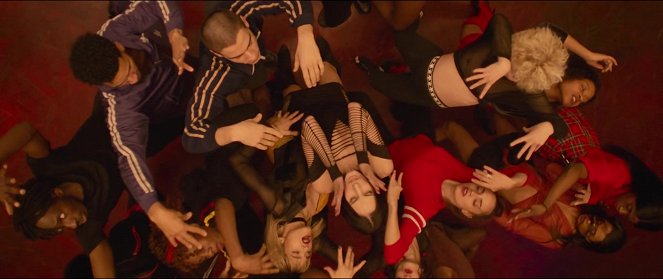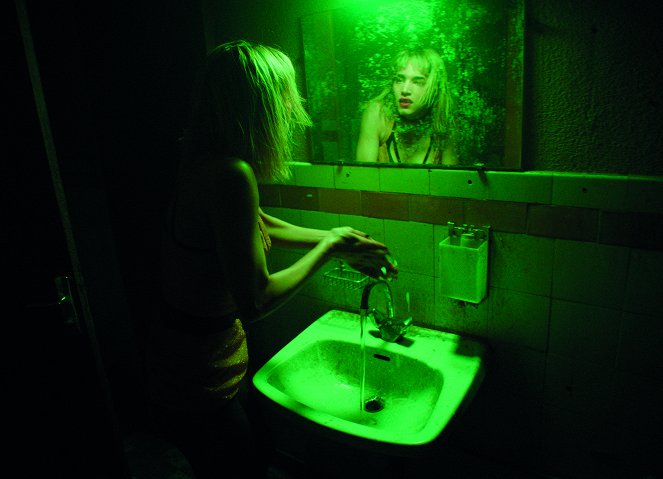Directed by:
Gaspar NoéScreenplay:
Gaspar NoéCinematography:
Benoît DebieCast:
Sofia Boutella, Romain Guillermic, Souheila Yacoub, Kiddy Smile, Claude Gajan Maude, Giselle Palmer, Taylor Kastle, Thea Carla Schott, Sharleen Temple (more)VOD (4)
Plots(1)
Following a successful rehearsal, a dance troupe set about celebrating with a party. But when it becomes apparent that someone has spiked the sangria, the joyous atmosphere soon transforms into a nightmarish hellscape of violence and twisted carnality as the dancers begin to turn on each other in an orgiastic frenzy. (Arrow Films)
Videos (3)
Reviews (12)
When I see Gaspar Noé's name, I’m instantly intrigued. I expect an abstract concept, absurd execution, all set to the vibe of 90s French techno and house. And Climax delivers exactly that. Cinematically, it’s a masterpiece. The opening dance scene is a brilliant example of how even in the midst of chaotic movement, there’s a sense of order. It’s a great introduction to the dancers, who then engage in slightly tedious, nonsensical chatter to introduce themselves—a nod to 80s horror that earned my respect. But then, the real madness begins. Words can’t do it justice; you just have to see it. It’s pure insanity on screen—shots that play with sound, visuals, backgrounds, and a camera that creates unbelievable sequences. And above all, the unfolding chaos is something you could never imagine.
()
Gaspar Noé’s films are a genre of their own – you won’t see anything like them anywhere else. Climax is packed with all the signature elements fans of this wild innovator will appreciate. Essentially, it’s a trippy dance movie that will have uninitiated viewers fleeing the theater within the first third. While I’m not usually a fan of experimental films, I always look forward to Noé’s cinematic experiments. The use of the camera here is absolutely brilliant, with some incredibly impressive long takes – even if it’s clear there are hidden cuts. If you’re curious about what it looks like to be on a really bad trip, Climax is the film for you. However, if you don’t enjoy watching a bunch of unlikable characters dance, drink, do drugs, and talk about sex – and then lose their minds on LSD – all shot in an extremely unconventional style, then steer clear. Good thing I don't drink sangria...
()
Gaspar Noé dances an extremely dirty dance, and with his help, this manages to entrance and fascinate you for quite some time. And yet during the excessively stretched-out dialogue, a feeling arose that someone was stretching me out. And that was before the anticipated barrage of purposeless violence and annoying antics accompanied by the spinning of the camera was even on the program, and the fact that the stubborn director refused to move from one spot even a little bit after so many years almost made me laugh. And I had already lost my patience with works presented to the clever audience long ago.
()
We haven’t had a party gone wrong quite like this before. A brilliant one-shot musical intro, a few lines to get to know the characters and the party begins. For the participating unfortunates, a badly mixed sangria can work real magic. Climax is a super engaging acid trip. Out of Noé’s entire filmography, it is the most similar to Enter the Void, but this time taking place in a few rooms and one hallway. Dancing and frolicking, collective paranoia, hallucinogenic madness. The movie is tense and scary in places, but by Noé’s standards, it is quite restrained in terms of sex and violence. Four stars thanks to the festival atmosphere (or rather the constant hunger for innovative things), but otherwise it is just the same self-obsessed inanity with pseudo-philosophical insights as found in most of the director‘s filmography. [Cannes]
()
Almost every other better film critic has outlined a quick, more or less modest parallel between Bosch's depiction of Hell from the triptych "The Garden of Earthly Delights" and the second part of Noé's film, i.e., the "horror" part. It would be a mistake, as every other critic does, to separate the first part (before things go wrong) and the second part of the film, just as it is impossible to separate the parts of the triptych. Here, we can rely on the idea that was expressed in Jean Eustache's film about Bosch's Hell: "I really feel that it is in the third painting, in the description of Hell, where Bosch finally lets himself go. He lets himself be carried away by the description of pleasure, senseless and complete. This pleasure is so complete that even its consciousness is not present." If the relationship between painful pleasure and the attractiveness of terror is only a conscious contradiction, while at the level of the unconscious, it is the desired goal of the death urge, towards which we willingly walk with joyful tears of horror immediately after LSD disables our social inhibitors, it is a possibility that Noé does not precisely examine - he only shows it. That is his classic position for me: a mixture of shallowness and a desire for depth. Fortunately, we already know that contradictions are not mutually exclusive, but collide with each other, so it is not possible to give up on Noé's work for such reasons, just as Bosch also had a troubled relationship with perspective and, therefore, with the depth of the field; criticizing Noé for shallowness would be nothing more than bourgeois attachment to the conscious sphere of film.
()



Ads